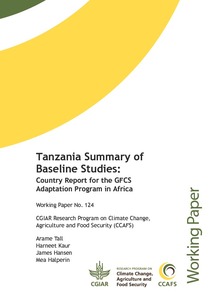Resource information
This report reflects upon the consolidated findings from the baseline and scoping studies conducted under the auspices of Global Framework for Climate Services (GFCS) Adaptation Programme in Africa. It identifies gaps in climate information access and use at the local level, type of climate services farmers and pastoralists need in Tanzania, relevant channels to reach farmers with requested services, lead-time and gender specific requirements.
We find that farmers and pastoralists in Tanzania rely more on their indigenous knowledge and personal experience than on science-based climate information to inform their crop and livestock decisions. Fewer than half of surveyed households in Kiteto and Longido acknowledged receiving climate information (with an even lower proportion in Longido). The most common climate information products currently received are seasonal rainfall onset and extreme event forecasts. Major gender differences emerged between districts; for example, in Kiteto 42% of male-headed households received forecasts versus 38% of those headed by females. In Longido, an area mainly populated by nomadic pastoralists, 42% of female- headed households received forecasts versus 25% of male-headed households. Some challenges to the use of climate information are a lack of trust in forecasts of climate events that do not unfold as predicted, timing, accuracy and the spatial scale of information.
The types of climate services farmers and pastoralists need in Tanzania are as following, ranked by order of importance: onset of rains, expected rainfall over the season, end of rainy season, number of days of rainfall and probability of extreme events. In Kiteto, men and women rank these the same way, while in Longido, men and women have different priorities. For women, forecast of expected rainfall over the season is their first priority (82%), followed by forecast of the start of the rains (59%). However the reverse is the case with men. They ranked forecast of the start of the rains first (63%) and forecast of expected rainfall over the season second (57%).
In all districts, radio emerges as the most important delivery channel. Subsequent to radio, rural women prefer to receive climate advisories and alerts as voice messages on cellphones, while men prefer extension agent visits. 47% of women own a radio while 70% of women own cell phones. Other non-negligible sources of climate information include visits from government extension workers, NGOs, word of mouth, friends and neighbours.


